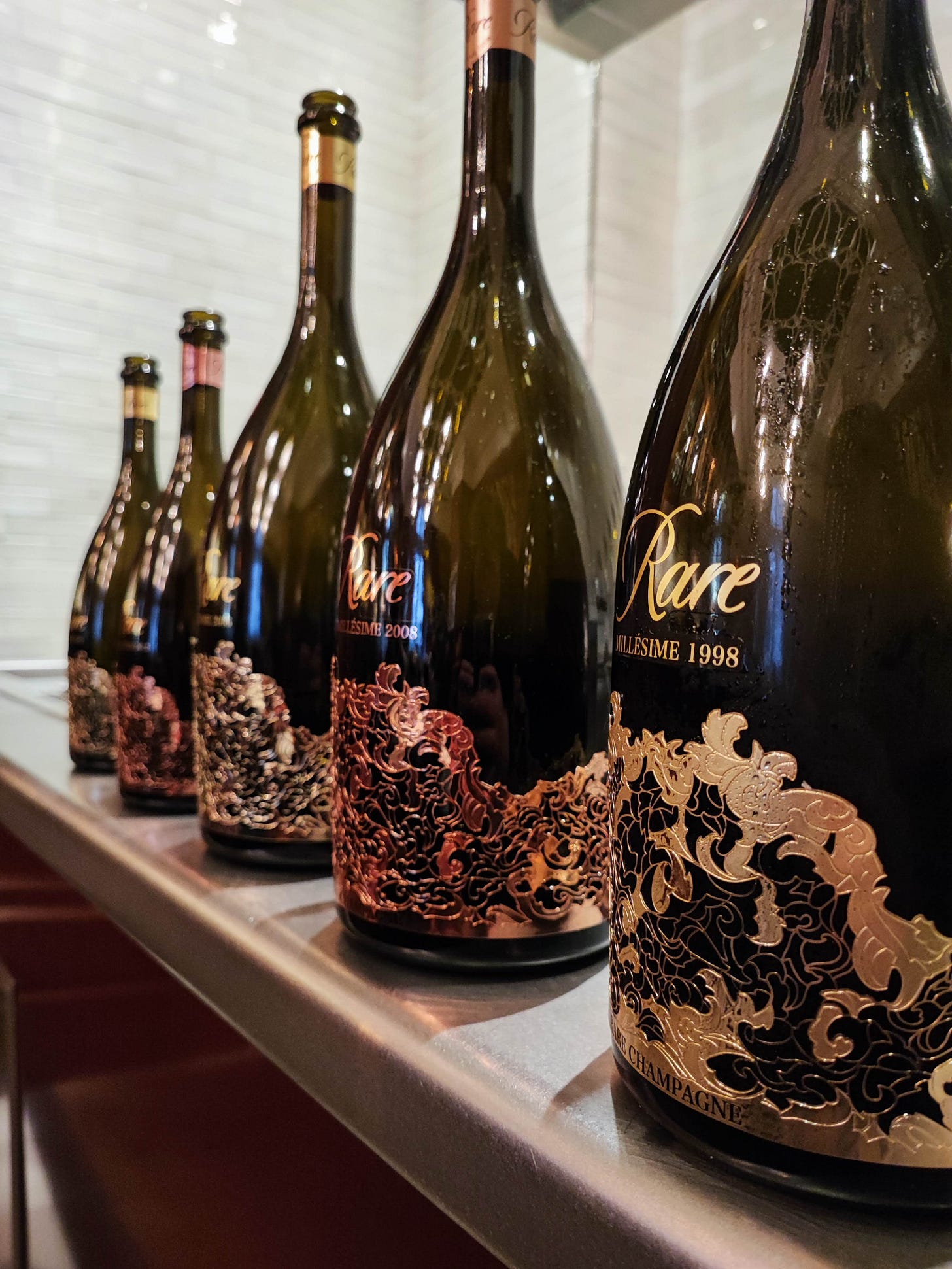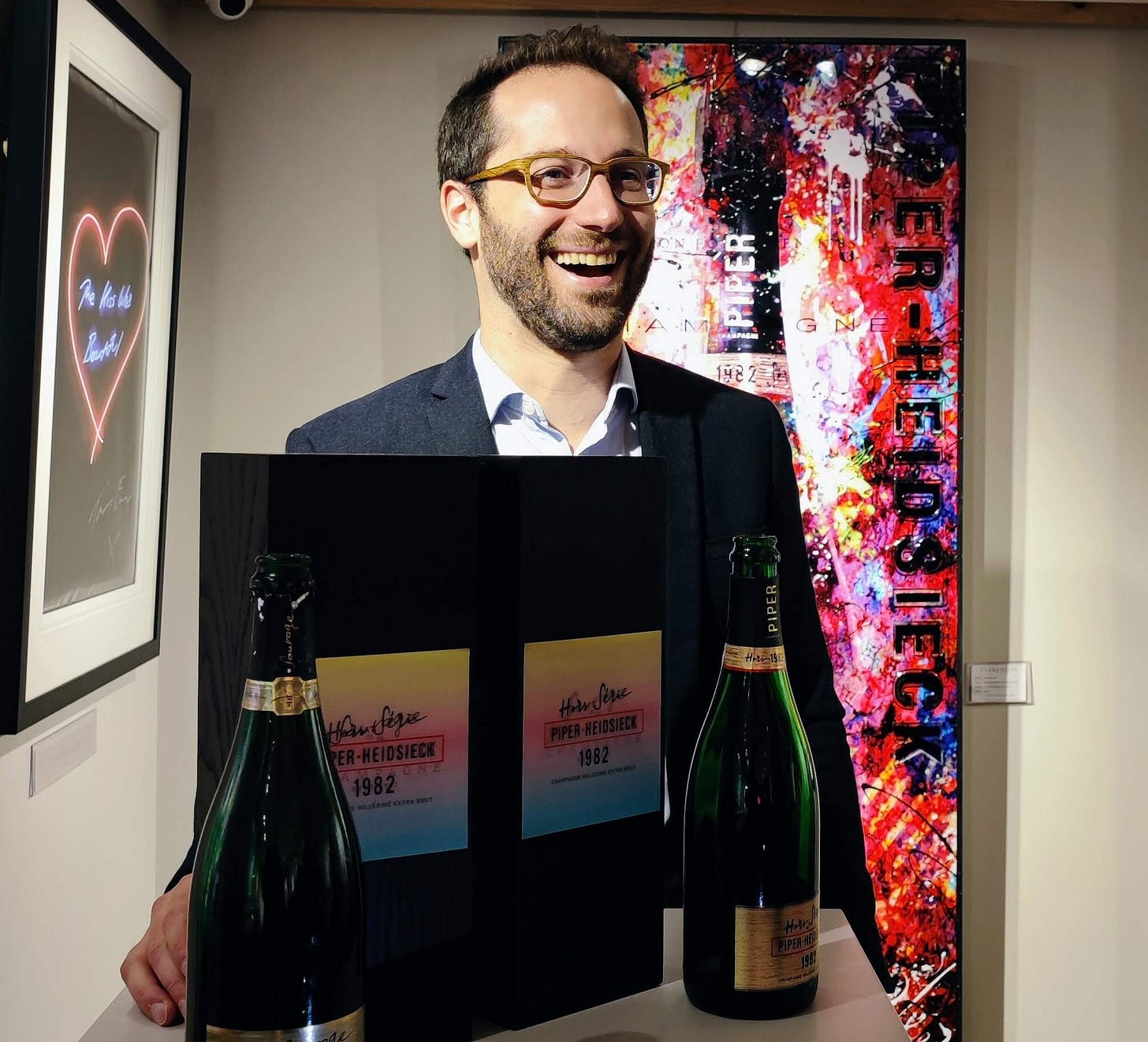Piper-Heidsieck Sauvage 1982 and Hors-Série 1982
It is currently 5.22 a.m, and I’m writing my Substack. Am I mad? No - just the victim of a baby that called my bluff. After a few up-and-down nights, getting to bed at 10pm seemed sensible. Lo and behold, seven undisturbed hours later, I’m up with the birds.
The birds have got the right idea, in my book. Last week I was on tour with a group of musicians I’ve known a long time. As we were headed into Wales, I suggested a fairly leisurely 9am lobby call in order to go and get up a hill and breathe some quality air (very important for us Londoners). There were no takers, though. For them, the joy of a hotel was to be able to do nothing all morning, and to leave as late as possible.
Fair enough. We are all different, and what feels different to us - novel, stimulating, a little treat to reset the system - is bound to differ, too. Back in London, it has been a week tasting wines that share the same grape varieties and the same production method, yet run on body clocks just as varied. The Piper-Heidsieck Hors-Série 1982 has had a monumental forty year lie-in, the Rare Rosé 2012 an impressive decade, the Pieter Ferreira Cap Classiques (profiled in the next newsletter) a perfectly-judged three or four years.
Why these differences? Ultimately, it comes down to place. There is no formula that says More = Better when it comes to lees-ageing champagne and other sparkling wines, although the number of wines outside Champagne that benefit from going past a decade is vanishingly small. Champagne is usually at pains to point out what it doesn’t have in common with other sparkling wines, and this long view on time is surely the most remarkable point of difference.
(It is now 6.14a.m, and my ears tell me I am no longer alone…)
Rare - The New Rosé 2012 and 2006 Magnum
Rare used to the the Prestige Cuvée of Piper-Heidsieck before busting out on its own after the 2002 vintage. In truth, of course, Piper and Rare are two peas if not in the same pod, then certainly on the same plant. After the retirement of cellar master Regis Camus last year, Piper cellar master Émilien Boutillat is now in charge of both.
When I started Six Atmospheres, Rare was a bit of an industry secret. To this day, commentators that reward big, dramatic and evolved champagnes tend not to score them as highly as those that find its mixture of sleek, succulent ripeness and precision irresistible. There’s no oak here. No hastening evolution. They are about vintage, fruit and assemblage, presented with absolute clarity. Time in the cellar after release sets to work on the next dimension of flavour.
Rare 2006 has always carried some of the extra weight of the vintage, a little roundness of butter toffee and chewy candied grapefruit, decadent and welcoming if not as cleanly-cut as both 2002 and 2008. Cue the ‘magnum effect’ in the Rare 2006 Magnum which, through the reduced ratio of oxygen to wine in the bottle, alters the dynamics of both fermentation and ageing. Everything is slower, tighter, more reductive - something that can really take a warm vintage like 2006 to the gym, tightening it up and pulling it into focus. The result is a magnum that offers up a tremendous amount of pleasure right now and over the next ten years.
Rare Rosé 2012 gives the impression of being a slightly more tender, approachable sort of creature than the 2008 (and the saturated, structured 2007), showing plenty of the ripeness of the year but put together with a delicate hand. There’s plenty of Rare’s trademark aromatic interest here, all of which will open out further with a little time on cork. An extremely fine release which nimbly navigates the lines between seriousness and accessibility, giving us (perhaps) a hint of what the straight Rare 2012 may offer.
Speaking of seriousness, the launch ended with a wine I’ve encountered once before - Rare Rosé 2008 Magnum. It’s extraordinary stuff, a strict, front-to-back line of 2008 acidity tethering an explosive set of flavours that will continue to shape-shift for decades yet. If you’re hungry for descriptors, think gunpowder and Szechuan pepper up top, fragrant mandarin and redcurrants, piles of tight, roasted citrus…graceful but almost too energetic, still. It really is a few notches up on the 75cl release, and one of the most remarkable Rosé champagnes I’ve tasted this year.
Piper-Heidsieck Hors-Série 1982 and Sauvage 1982
Chef de Cave Émilien Boutillat
Champagne houses are hoarders. The largest think nothing of squirrelling away a few thousand bottles of a particularly-interesting vintage release, simply for The Library. Most of these never see the light of day (or, at least, in the eyes of the public). So Piper-Heidsieck have to be commended for releasing two wines the likes of which few other Champagne producers are currently putting out.
Chef de Cave Émilien Boutillat began by likening 1982 to 2022 - a warm, solar vintage with what were, for then, high levels of ripeness at 9.5% potential alcohol in both Chardonnay and the Pinots. Yields were the highest on record in Champagne at the time. Piper’s vintage bottling at the time was called ‘Sauvage’, thanks to its history as one of the original low-dosage cuvées in Champagne. Boutillat chose to dose the re-release Hors-Série, disgorged this year after thirty-nine years on the lees, with the same dosage as the original disgorgement - 4 g/l.
The 1982 blend is 60% Pinot Noir (Verzy, Verzenay and Ambonnay) and 40% Chardonnay (Trépail, Ville-dommange, Villers-Marmery and Avize). The wine did not go through malolactic fermentation, which is keenly felt in the wine - in fact I’d say it is one of the reasons the Hors-Série is so pristine today. (Boutillat explained that the science behind malolactic was only just being revealed, and that producers had less control over the process than they do today).
So, the Hors-Série 1982. This may be an old wine, but it gets a very modern, quality-conscious disgorgement, each checked for flaws individually by Boutillat and then ‘jetted’ (a process that regulates oxygen ingress and ensures even ageing). The result is spellbinding stuff, a real time capsule of flavour and texture where the vintage character is still front-of-picture, without any of the browning/caramelised/dried-out flavours you’d usually expect in a wine of this age (the result of such long, protective ageing on lees, the second half of which was sur pointe, the bottles ageing on cork-down rather than horizontally after the effects of yeast autolysis have largely played out). With stunning fidelity and vivacity, this is one of the most fascinating champagnes I’ve tried this year. What’s more, it feels like it has more to give - unusual for such a late-disgorged cuvée.
Its companion piece, released in a box set of two is the original Sauvage 1982, aged on cork in the cellars at Piper. Exactly the same wine, this 1992 disgorgement showed just what a different trajectory a wine takes after the lees are removed and liqueur d’expedition (a mixture of sugar and wine) is added. A deeper colour, it showed many similar traits, especially on the palate, with its refreshingly-terse acidity, but thrown in a hugely appealing golden light; honey, malt and marmalade over the fruit, more front-loaded in shape and evolved in flavour. If the Hors-Série is Spring, then the Sauvage is Autumn. Time for both, then.
Full notes and scores will be published for all champagnes tasted this year in the Tim Atkin Champagne Special Report 2022.







